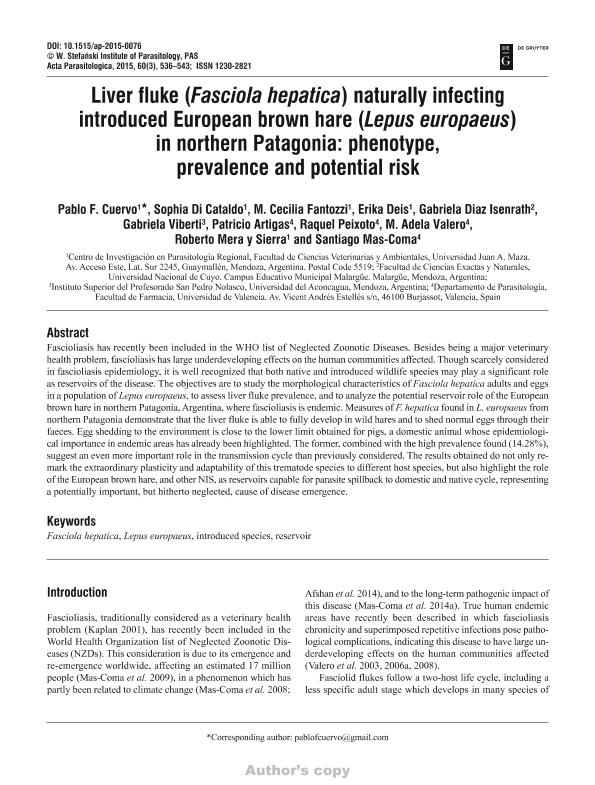Artículo
Liver fluke (Fasciola hepatica) naturally infecting introduced European brown hare (Lepus europaeus) in northern Patagonia: Phenotype, prevalence and potential risk
Cuervo Bustamante, Pablo Fernando ; Cataldo, Sophia Di; Fantozzi, María Cecilia
; Cataldo, Sophia Di; Fantozzi, María Cecilia ; Deis, Erika; Diaz Isenrath, Gabriela Beatriz
; Deis, Erika; Diaz Isenrath, Gabriela Beatriz ; Viberti, Gabriela; Artigas, Patricio; Peixoto, Raquel; Valero, M. Adela; Mera y Sierra, Roberto; Mas-coma, Santiago
; Viberti, Gabriela; Artigas, Patricio; Peixoto, Raquel; Valero, M. Adela; Mera y Sierra, Roberto; Mas-coma, Santiago
 ; Cataldo, Sophia Di; Fantozzi, María Cecilia
; Cataldo, Sophia Di; Fantozzi, María Cecilia ; Deis, Erika; Diaz Isenrath, Gabriela Beatriz
; Deis, Erika; Diaz Isenrath, Gabriela Beatriz ; Viberti, Gabriela; Artigas, Patricio; Peixoto, Raquel; Valero, M. Adela; Mera y Sierra, Roberto; Mas-coma, Santiago
; Viberti, Gabriela; Artigas, Patricio; Peixoto, Raquel; Valero, M. Adela; Mera y Sierra, Roberto; Mas-coma, Santiago
Fecha de publicación:
09/2015
Editorial:
Versita
Revista:
Acta Parasitologica
ISSN:
1230-2821
e-ISSN:
1896-1851
Idioma:
Inglés
Tipo de recurso:
Artículo publicado
Clasificación temática:
Resumen
Fascioliasis has recently been included in the WHO list of Neglected Zoonotic Diseases. Besides being a major veterinary health problem, fascioliasis has large underdeveloping effects on the human communities affected. Though scarcely considered in fascioliasis epidemiology, it is well recognized that both native and introduced wildlife species may play a significant role as reservoirs of the disease. The objectives are to study the morphological characteristics of Fasciola hepatica adults and eggs in a population of Lepus europaeus, to assess liver fluke prevalence, and to analyze the potential reservoir role of the European brown hare in northern Patagonia, Argentina, where fascioliasis is endemic. Measures of F. hepatica found in L. europaeus from northern Patagonia demonstrate that the liver fluke is able to fully develop in wild hares and to shed normal eggs through their faeces. Egg shedding to the environment is close to the lower limit obtained for pigs, a domestic animal whose epidemiological importance in endemic areas has already been highlighted. The former, combined with the high prevalence found (14.28%), suggest an even more important role in the transmission cycle than previously considered. The results obtained do not only remark the extraordinary plasticity and adaptability of this trematode species to different host species, but also highlight the role of the European brown hare, and other NIS, as reservoirs capable for parasite spillback to domestic and native cycle, representing a potentially important, but hitherto neglected, cause of disease emergence.
Palabras clave:
Fasciola Hepatica
,
Introduced Species
,
Lepus Europaeus
,
Reservoir
Archivos asociados
Licencia
Identificadores
Colecciones
Articulos(ICIVET-LITORAL)
Articulos de INST. DE CIENCIAS VETERINARIAS DEL LITORAL
Articulos de INST. DE CIENCIAS VETERINARIAS DEL LITORAL
Citación
Cuervo Bustamante, Pablo Fernando; Cataldo, Sophia Di; Fantozzi, María Cecilia; Deis, Erika; Diaz Isenrath, Gabriela Beatriz; et al.; Liver fluke (Fasciola hepatica) naturally infecting introduced European brown hare (Lepus europaeus) in northern Patagonia: Phenotype, prevalence and potential risk; Versita; Acta Parasitologica; 60; 3; 9-2015; 536-543
Compartir
Altmétricas



